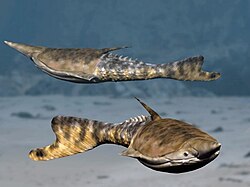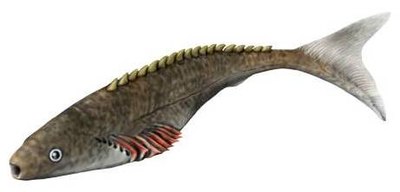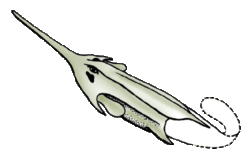Zoology of Egypt (1898) (Varanus griseus)
Title: Zoology of Egypt
Year: 1898 (1890s)
Authors: Anderson, John, 1833-1900 Boulenger, George Albert, 1858-1937. Fishes of the Nile De Winton, William Edward
Subjects: Zoology
Publisher: London, B. Quaritch
Contributing Library: Harvard University, Museum of Comparative Zoology, Ernst Mayr Library
Digitizing Sponsor: Harvard University, Museum of Comparative Zoology, Ernst Mayr Library
View Book Page: Book Viewer
About This Book: Catalog Entry
View All Images: All Images From Book
Click here to view book online to see this illustration in context in a browseable online version of this book.
Text Appearing Before Image:
nitor griseus, Peters, Mon. Berl. Ak. 1870, p. 109. Varanus (Psammosaurus) arenarius, Bedr. Bull. Soc. Nat. Mosc. 1879, no. 3, p. 40.Varanus griseus, Blgr. Cat. Liz. B. M. ii. 1885, p. 306; Trans. Linn. Soc. Lond., Zool. v. 1889, p. 99; Fauna Brit. Ind., Rept. 1890, p. 163; Trans. Zool. Soc. xiii. 1891, p. 121; Boettger, Zool. Jahrb. iii. 1888, p. 904; Kat. Rept. Mus. Senck. 1893, p. 49; Anderson, Proc. Zool. Soc. 1895, p. 636 ; Herpet. Arabia & Egypt, 1896, pp. 34, 101; Zander, Zool. Garten, xxxvi. 1895, p. 298; Werner, Verh. zool.-bot. Ges. Wien, xliv. 1894, p. 79; Francaviglia, Boll. Soc. Rom. Zool. v. 1896, p. 46.1 $ . Suez. 1 cJ. Desert N.E. of Cairo.1 ? . Gizeh Desert.1 ? . Tel el Amarna. Prof. W. M. Flinders Petrie, D.C.L. 1 J1 and 1 juv. Suakin. Surgeon-Captain Penton, D.S.O. 2 £ and 2 ? . Suakin.1 J . Tokar. Teeth acute, compressed. Snout slightly depressed at the tip. Canthus rostralismoderately denned. Nostril oblique, rather large and crescentic, close to the eye, its
Text Appearing After Image:
w a Pi Zo ° < - Pi *° VAEANUS GEISBUS. 135 distance from the end of the snout being about four times greater than the intervalbetween it and the eye. Tail rounded at the base, slightly compressed posteriorly; nodorsal ridge. Digits rather short; claws strong and curved. Scales on the uppersurface of the head, including the supraoculars, very small, juxtaposed, smooth,generally hexagonal. Scales on the body and limbs small, rounded or oblong,sometimes feebly keeled, larger than ventrals, those on the sides of the neck generallyconical; ventrals smooth, 110-125 between the fold of the neck to the groin. Caudalscales small, more or less keeled above and below. General colour sandy yellow, with narrow brownish longitudinal lines varying inintensity along the side of the neck, and similarly coloured bands or lines across theback and tail, becoming lost in some adults towards the tip; the upper surface of thebody sometimes with yellow spots. The young is generally pale rufous yellow ab
Note About Images
Relevantní obrázky
Relevantní články
ObratlovciObratlovci jsou podkmen strunatců, u kterých došlo k vytvoření vnitřní chrupavčité nebo později kostěné kostry přítomné alespoň ve formě lebky a obratlů. Obratlovci se dále vyznačují zřetelnou hlavovou částí, která nese smyslové orgány a obsahuje trojdílný mozek, který signály ze smyslových orgánů zpracovává a koordinuje činnost těla. V embryonálním vývoji hlavy a dalších částí těla mají u obratlovců mimořádný význam buňky neurální lišty, které se formují během neurulace, migrují po těle embrya a přispívají k formování mnoha tkání a orgánů. Vzhledem k aktivnímu způsobu života obratlovců u nich lze nalézt řadu dalších evolučních novinek spjatých s vyššími nároky metabolismu. Velmi důležitou inovací obratlovců je také jejich unikátní adaptivní imunitní systém založený na B a T lymfocytech. Velmi brzy během evoluce obratlovců došlo ke dvojí duplikaci genomu, což patrně podpořilo plasticitu regulačních mechanismů a usnadnilo evoluci nových struktur. .. pokračovat ve čtení









































